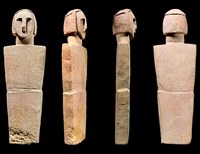Introduction
Temple and Tomb: Prehistoric Malta, 3600-2500 BCE
The ancient inhabitants of the Maltese archipelago created one of the artistically richest early prehistoric cultures. They produced an outstanding range of refined representations of the human figure and constructed extraordinary megalithic monuments now understood to be the oldest surviving freestanding stone buildings in the world. While many ancient cultures built with megaliths (literally, “large stones”), the exterior walls are constructed from massive slabs of limestone up to 4 meters high that weigh up to 21 tons each. Even more remarkably, this was achieved without the use of any metal tools.
Through the 1950s, it was believed that Maltese culture developed via “diffusion” under the influence of Bronze Age Greece, and thus the monuments were dated to the second and first millennia BCE. However, radiocarbon dating has recently demonstrated that these dates were too young by thousands of years, and the dates for Maltese prehistory are now fixed in the fifth to third millennia BCE. Initially many scholars found this inconceivable, but it is now clear that the prehistoric Maltese cultures developed independently and were earlier than even the Egyptian pyramids or Stonehenge.

The first permanent settlers arrived in the Maltese islands in the late sixth millennium BCE. They came by boat from Sicily with everything they needed to homestead the empty islands: domesticated animals, such as cattle, goats, sheep, and pigs; seed grains; and pottery technologies. The great temples themselves and the objects in the exhibition date to the later phases of the Temple Period, 3600–2500 BCE. Chronologically, this phase of Maltese history parallels the development of metallurgy in nearby regions, but no copper has been found at Temple Period sites.
The great monuments of the Maltese islands are commonly referred to as “temples,” although their exact function is not precisely known. Their size and intricacy and the effort expended on their construction indicate that they played a very important role in the ongoing life of the community, and some appear to be designed to align with celestial phenomena. Eventually at least twenty-four megalithic temples were built at fourteen sites, each complex located near good agricultural land. Each group of temples may have represented the territory of separate communities that shared a common culture and religion. Scholars have suggested that, lacking signs of warfare during the Temple Period, competition among groups was sublimated into temple building and possibly other activities that have left no trace, such as athletic or cultural contests.
This civilization came to an end around 2500 BCE, shortly after its peak, and the islands were subsequently abandoned for a period of centuries. Reasons for the disappearance of this culture are unclear, but may include aspects of war or foreign invasion, exhaustion of natural resources, or climate change. The Bronze Age population that later resettled the islands comprised a completely distinct people. Its cultural traditions are entirely separate, although at Tarxien these inhabitants chose to bury their dead within the massive ruins of the great temples.
Image: “Shaman’s Cache Schematic Figure,” Wearing a Plain Headband Globigerina Limestone. H. 17.2, W. 5.4, D. 1.8 cm
Xagħra Circle (Gozo), 3600–2500 BCE
Heritage Malta–Gozo Museum of Archaeology: 32191
Courtesy of Heritage Malta, photography © Daniel Cilia